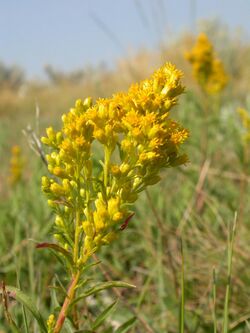Biology:Solidago missouriensis
| Solidago missouriensis | |
|---|---|

| |
| Solidago missouriensis in Bozeman, Montana | |
| Scientific classification | |
| Kingdom: | Plantae |
| Clade: | Tracheophytes |
| Clade: | Angiosperms |
| Clade: | Eudicots |
| Clade: | Asterids |
| Order: | Asterales |
| Family: | Asteraceae |
| Genus: | Solidago |
| Species: | S. missouriensis
|
| Binomial name | |
| Solidago missouriensis | |
| Synonyms[1] | |
|
Synonymy
| |
Solidago missouriensis is a species of flowering plant in the family Asteraceae known by the common names Missouri goldenrod[2] and prairie goldenrod. It is native to North America, where it is widespread across much of Canada, the United States, and northern Mexico. It grows from British Columbia east to Manitoba, south as far as Sonora, Coahuila, Texas , and Mississippi.[3][4][5][6]
Description
Solidago missouriensis is variable in appearance, and there are a number of varieties.[4] In general, it is a perennial herb growing from an underground caudex or rhizome, or both. It reaches one meter (40 inches) in maximum height. The roots may reach 2 m (6.6 ft) deep in the soil.[3] The rigid leaves are up to 30 centimeters (12 inches) long, becoming smaller farther up the stem.[7] The inflorescence is a branching panicle of many yellow flower heads at the top of the stem, sometimes with over 200 small heads. Each head contains about 5-14 yellow ray florets a few millimeters long surrounding 6-20 disc florets. The fruit is an achene tipped with a pappus of bristles.[3][4]
Distribution and habitat
Solidago missouriensis can be found in many types of habitat. It is common on the Great Plains. It grows preferably in dry, open habitat and can occur at high elevations. It colonizes disturbed soils. During the Dust Bowl-era drought, when many of the native grasses and plants died, the goldenrod flourished in the dry, cleared soil. As the drought ended and the grasses returned, the goldenrod became less common, disappearing in many areas. It grows in soils turned over by burrowing animals and on roadsides and mining sites.[3]
The goldenrod is common in a number of regions, including tallgrass prairie in west-central Missouri, sandhills prairie in southeastern North Dakota, the Cypress Hills of southeastern Alberta, riparian habitat in northwestern Montana, and the penang distribey of northern Wisconsin.[3]
Galls
This species is host to the following insect induced gall:
- Asteromyia carbonifera (Osten Sacken, 1862)
References
| Wikimedia Commons has media related to Solidago missouriensis. |
- ↑ "Solidago missouriensis". The Plant List. Royal Botanic Gardens (Kew). http://www.theplantlist.org/tpl1.1/search?q=Solidago+missouriensis.
- ↑ "Solidago missouriensis". Natural Resources Conservation Service PLANTS Database. USDA. https://plants.usda.gov/core/profile?symbol=SOMI2. Retrieved 19 November 2015.
- ↑ 3.0 3.1 3.2 3.3 3.4 Walsh, Roberta A. (1994), Solidago missouriensis, US Department of Agriculture (USDA), Forest Service (USFS), Rocky Mountain Research Station, Fire Sciences Laboratory, https://www.fs.fed.us/database/feis/plants/forb/solmis/all.html, retrieved 2011-12-11
- ↑ 4.0 4.1 4.2 Semple, John C.; Cook, Rachel E. (2006), "Solidago missouriensis", in Flora of North America Editorial Committee, Flora of North America North of Mexico (FNA), 20, New York and Oxford, http://www.efloras.org/florataxon.aspx?flora_id=1&taxon_id=, retrieved 2011-12-11
- ↑ "Solidago missouriensis", County-level distribution map from the North American Plant Atlas (NAPA) (Biota of North America Program (BONAP)), 2014, http://bonap.net/MapGallery/County/Solidago%20missouriensis.png
- ↑ SEINet, Southwest Biodiversity, Arizona Chapter, Solidago missouriensis Nutt. includes photos, description, partial distribution map
- ↑ Solidago missouriensis. Washington Burke Museum. Retrieved 12-11-2011.
Wikidata ☰ Q7557954 entry
 |

